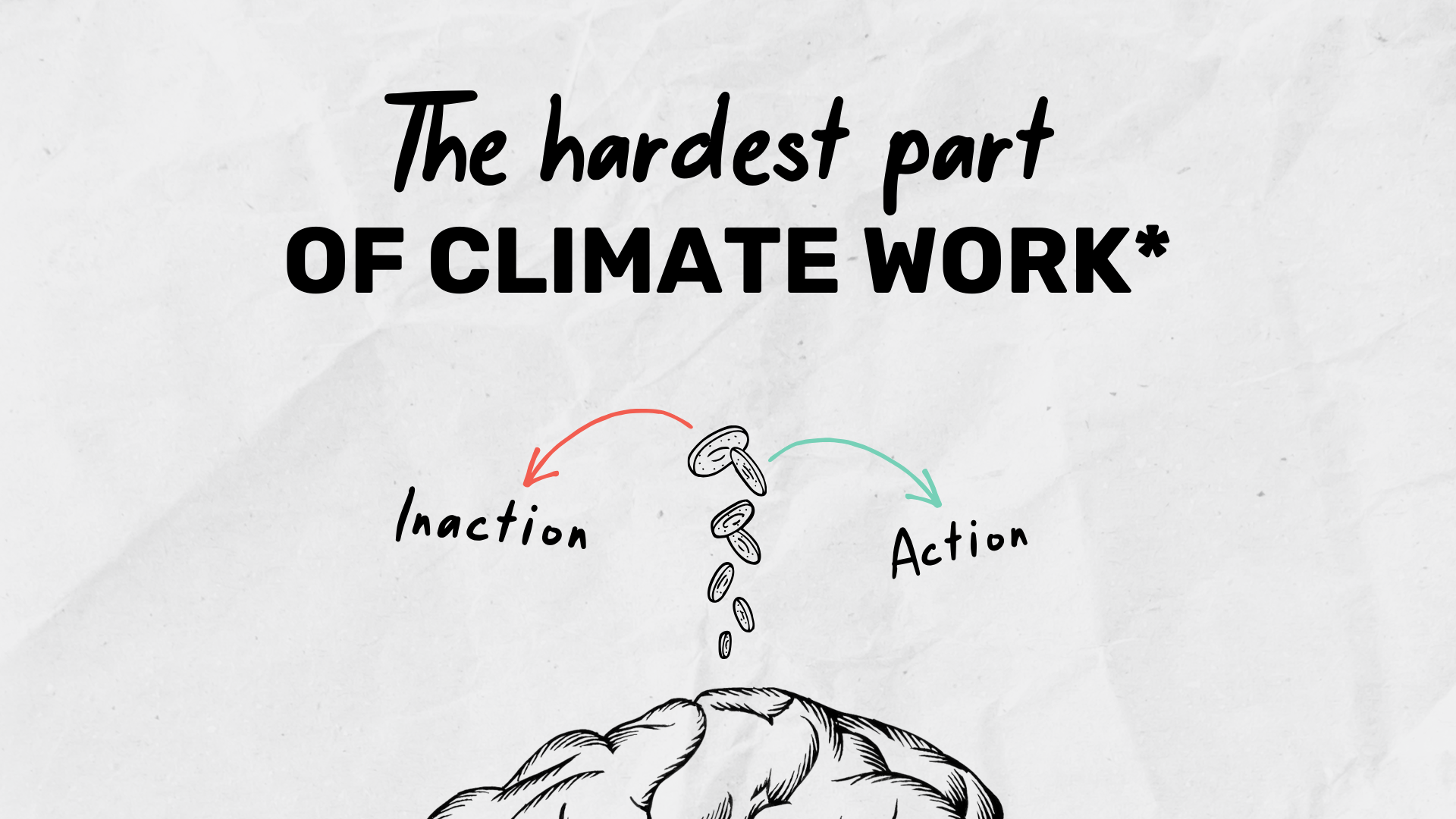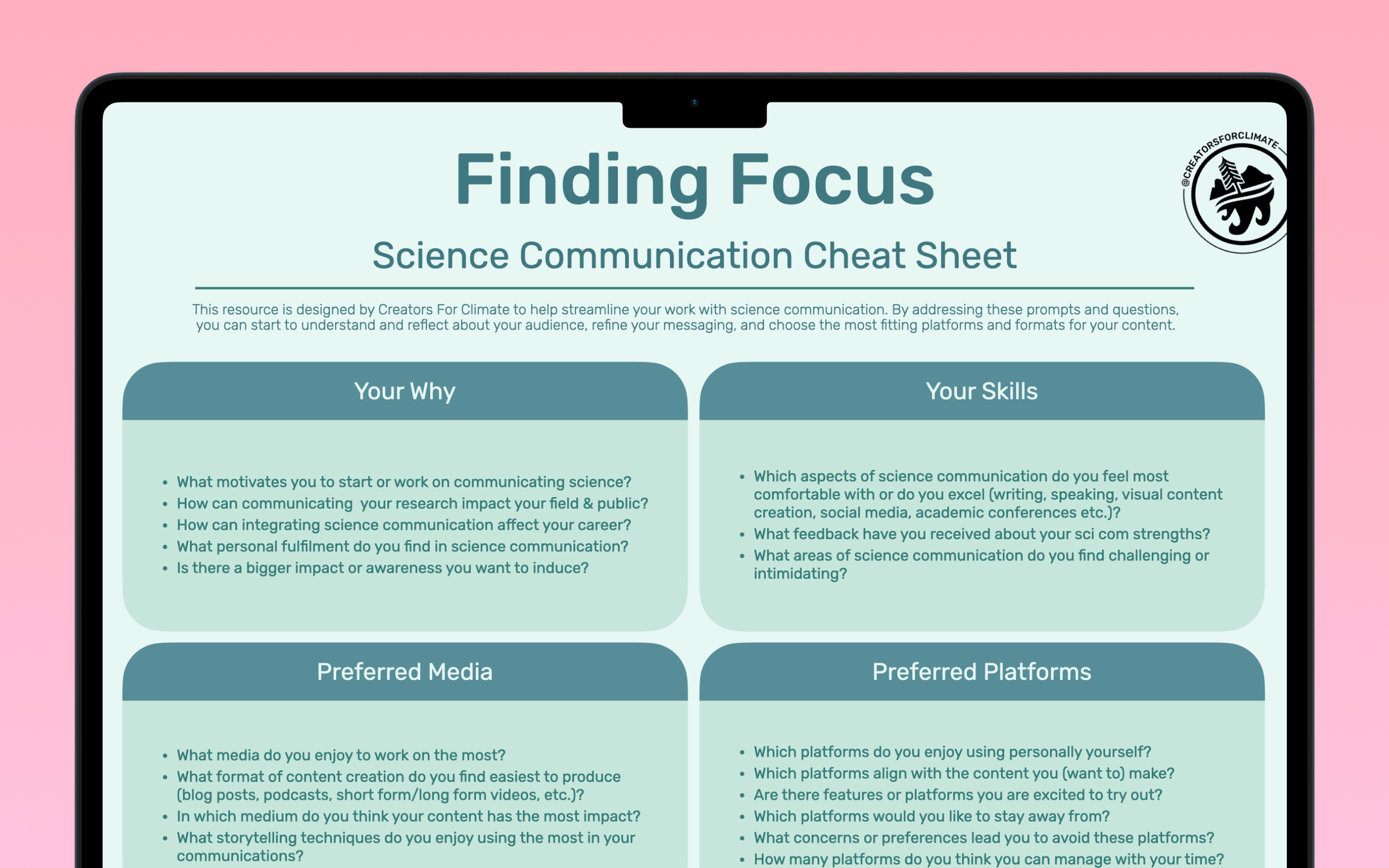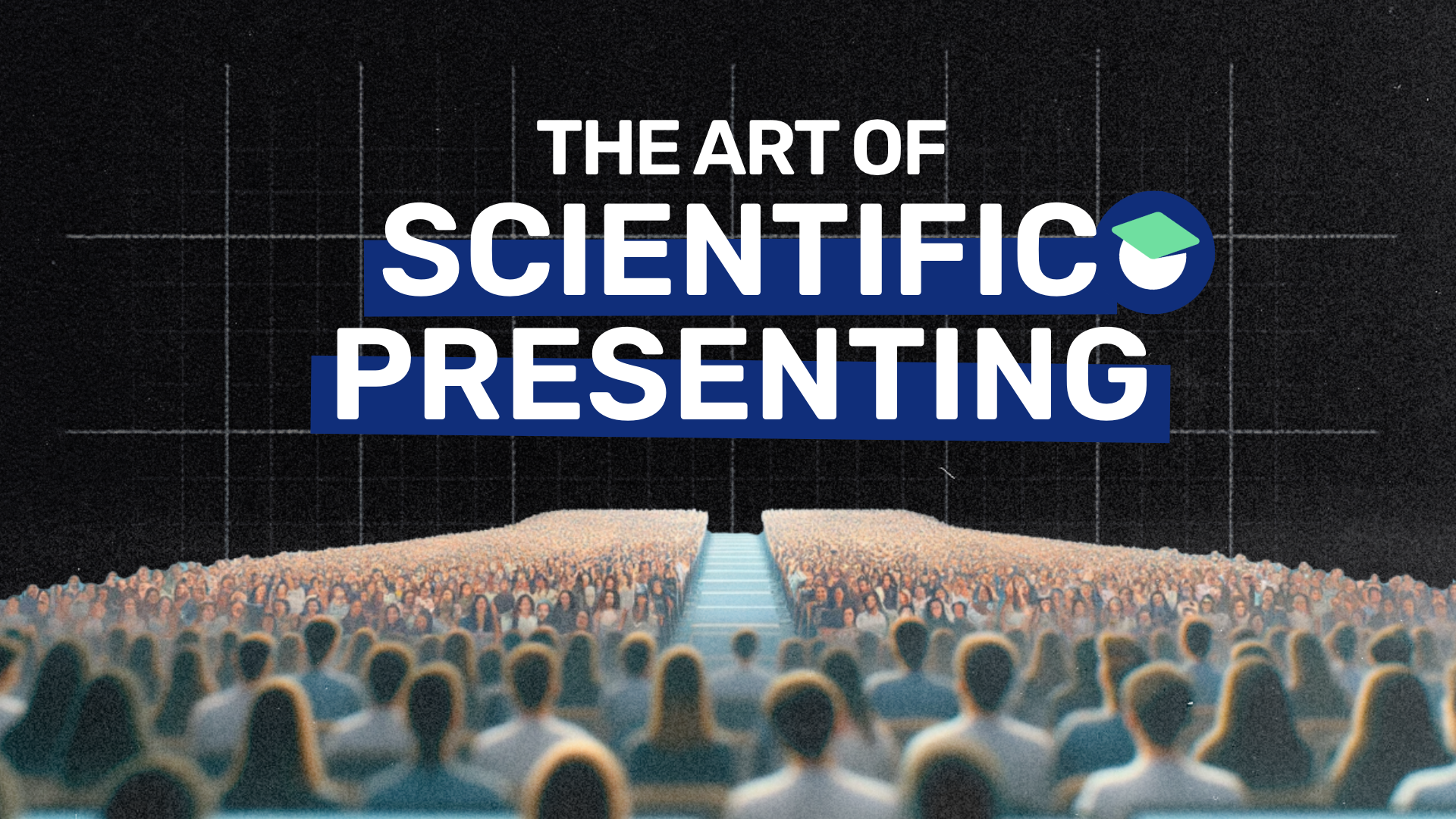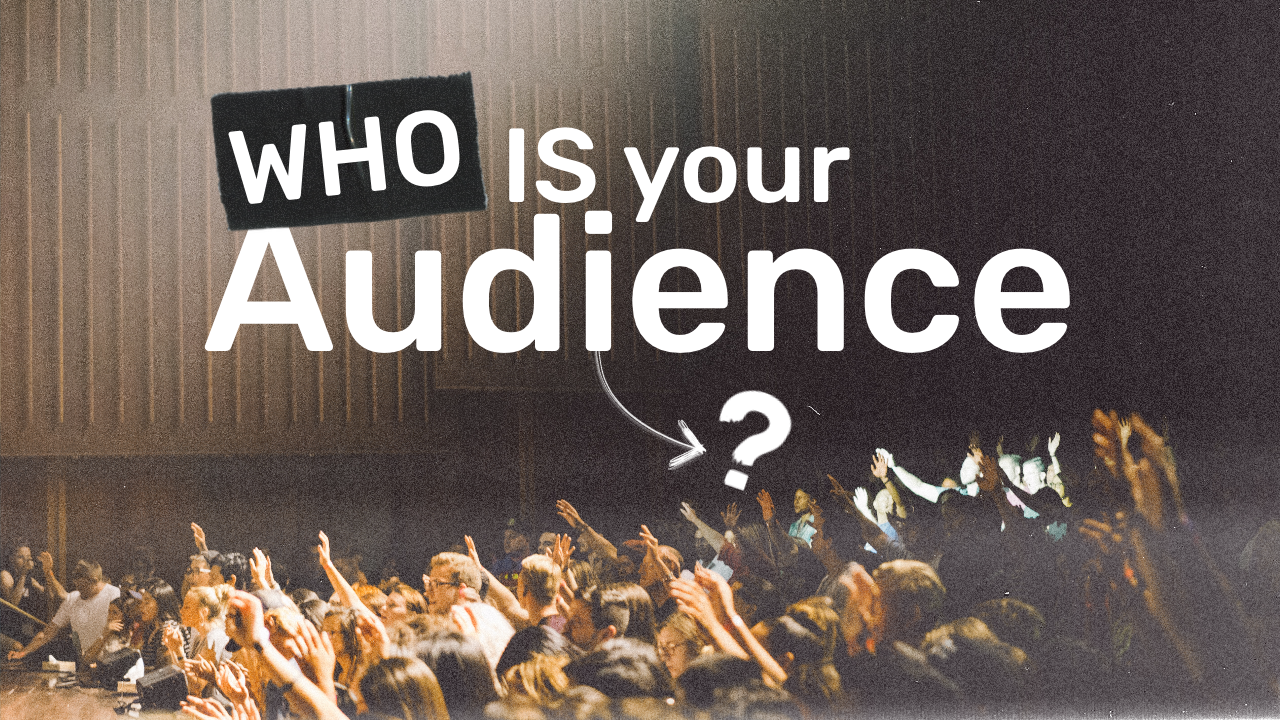Take a minute to read the blog
About creating climate content and science communication.
Our Role as Climate Creators (and yours too?)
Every year around this time, inboxes fill with the same messages: a veggie challenge, swap your coffee cups for reusables, buy local produce, eat locally. And while these things matter (a lot), they tend to frame climate action as an annual checklist. Well, Earth Day is here again pretty soon, and this time we’re collaborating with EARTHDAY.ORG to shift that conversation.
Let’s talk worldviews, fear and the courage to speak up.
Some of you might recognize this sentiment: "I'm not sure if I can continue. I worked so hard for the cause, but it all seems to be for nothing nowadays". It's a vibe our field has been hit with... hard. Let's dissect that through these 4 different lenses below.
5 Psychological barriers to connecting with your audience
What if we stopped trying to convince and instead started connecting? In this entry we'll look at creating campaigns with impact. How changing behavior starts with the way you talk to your target audience.
What do you call creators who talk about climate?
Seriously, what do you call a creator who integrates climate and environmental themes into their storytelling? No, this is not the start of a joke, but a niche with an identity crisis.
How Neil deGrasse Tyson thinks about climate change
If you’re a climate communicator, an activist or just a human trying to make sense of it all, it’s easy to feel consumed by the chaos. We'll take a look at how we can find back our peace and calm. Anxiety can be overwhelming, but that doesn't mean there is no light at the end of the tunnel.
5 Rules of Sanity in a world on fire
If you’re a climate communicator, an activist or just a human trying to make sense of it all, it’s easy to feel consumed by the chaos. We'll take a look at how we can find back our peace and calm. Anxiety can be overwhelming, but that doesn't mean there is no light at the end of the tunnel.
Find Focus and build a Personal Brand that connects with your Audience.
What makes those big name creators and science communicators more successful than others? It’s a question I’ve been racking my brain over for the past decade and I decided to do some digging. This blog dives into the key aspects that all these ‘personal brands’ have in common: Focus in their work, knowing their audience in and out and adapting their communication style to fit their audience.
How to come up with content ideas for your research.
In this post we’ll look at a practical exercise designed to help scientists and researchers create engaging social media content from their work. We’ll see how you can brainstorm possible topics to talk about or even better, come up with a bunch of ideas that you can turn into social media content. Let’s get started!
From traditional science posters to social media slides with the AIDA framework.
Carousel and slide posts, many people love them, we science communicators should adore them. These posts are essentially a modern day slideshow and are especially useful for presenting complex scientific topics in a format that is easy to digest and visually engaging. With this blog let’s explore how to create these ‘carousels’, and how you can turn those traditional science posters into actual engaging social media posts using the AIDA method.
Master “The Art of Scientific Presenting” with this Online Course
Introducing a class to learn more about academic presenting. As partner of the RALDE project, Creators For Climate got to collaborate on creating a course with the focus on disseminating scientific
research. With this course we got to sit down with students and teachers, to understand the needs and especially the pains when it comes to presenting your research to the scientific community. We went back to the basics and created an online course that will get you started, wherever you are in your presenting journey. So let’s see what you can expect from these lessons.
Why Conspiracy Theories Thrive and what we can learn from them.
Ever since the pandemic I’ve found myself curious as to why someone might hold such a strong belief into these wild theories. Interacting with these ‘Facebook warriors’, friends and even family, I asked myself how we can have conversations to address some objective truths that won’t lead into name calling and verbal abuse. In this article, I’m going to share some insights I picked up about the world of conspiracy theories, exploring their impact on our sense of belonging. What can we learn about the people behind the conspiracy?
Why Science Communication is important to combat Climate Change
Climate change is undeniably one of the most pressing issues of our era. While the scientific community is hard at work researching and understanding the intricacies of this global challenge, there's another equally crucial task at hand: communicating these findings to the public. In this article, we’ll take a plunge into the significance of science communication in addressing climate change and some tools you can use in the collective fight against this, existential, threat.
Overcoming Common Challenges in Science Communication
For many scientists, especially aspiring PhDs and young researchers, the journey of science communication is filled with challenges. Conveying complex ideas in an accessible manner can often feel like translating a foreign language. But there is hope! When you know what will hold you back or slow you down, you can start to think ahead. With the right strategies in place, these hurdles can be transformed into stepping stones. Let's look into some common challenges faced by us science communicators and explore how to solve them.
Consistency: The secret sauce of successful Creators.
Have you ever wondered how your favourite creators manage to consistently deliver great content? Why is it that some individuals seem to effortlessly produce a constant stream of articles, videos, or podcasts while others struggle to even start? The truth is, creating content on a consistent basis requires more than just sheer motivation and dedication; it is a mindset rooted in discipline, adaptability, and passion. But… you can learn to incorporate it into your own workflow!
Creating Your First Science/Climate Content
Navigating the world of science communication can be a rewarding journey, yet challenging if you don’t know where to start. I want to take you through the thought processes you have to go through while you are making content about a certain topic. Let’s start at the start:
Choosing the Right Platform for Your Science / Climate Content
The first question I hear most about starting with science communication is: WHERE DO I EVEN START? Today it seems like the platforms for sci com are as diverse as the topics they cover. From traditional print to the dynamic world of social media, each platform offers unique opportunities… and challenges. But how do you choose the right platform for your science content?
Why Knowing Your Audience is the Key to Science Communication
You might have heard this before: the message is only half the equation. The other half? That could very well be your audience. In science communication, understanding who you're communicating to is a key concept that is often overlooked. It’s shaping not only your content but also the delivery, tone, and medium of your message.
How Can I Find My Unique Voice in Science Communication?
Finding your unique voice can be both a challenge and an adventure. It will lead you to be your authentic self, whatever the medium you choose. With so many platforms available, how can you ensure that your message stands out, resonates, and makes a lasting impact? This journey of self-discovery does require some introspection, experimentation, and a dash of creativity. So let's delve into some actionable tips and techniques to help you use your personal strengths in communicating science. Because your voice matters!
From Scientific Papers to Social Media posts
Science communication has undergone a profound transformation over the years. From the professional halls of academia to the noisy world of social media. The way we communicate scientific findings has evolved to meet the changing needs of society. One of my professors told me: to know where you are going, you need to know what came before you. So let’s have a look at the evolution of science communication.
The case for Science Communication
I remember advocating for more science communication classes back when I was in university. With everything that has been happening in the world, good and bad, we can safely say science communication plays an instrumental role in bringing our beloved science to the general public. It gives us scientists the ability to translate complex systems and processes into bitesized and digestible pieces of information. But… how?






















